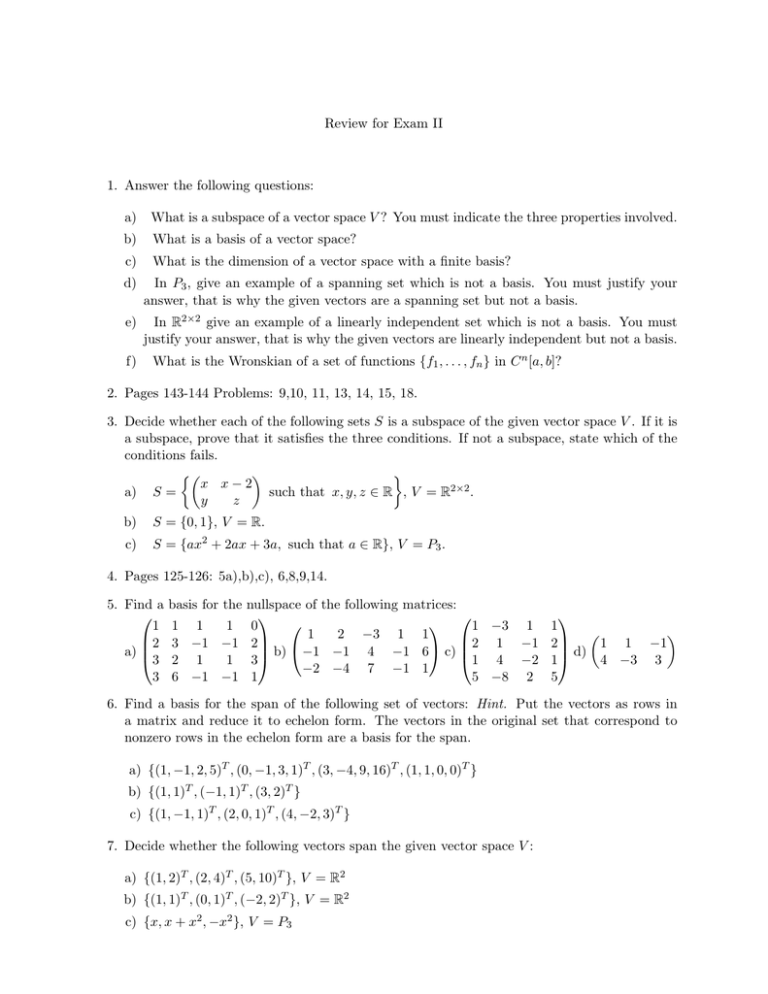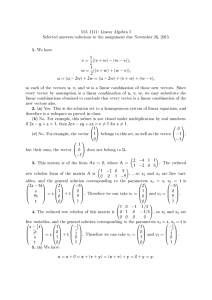Review for Exam II 1. Answer the following questions: a)
advertisement

Review for Exam II
1. Answer the following questions:
a)
What is a subspace of a vector space V ? You must indicate the three properties involved.
b)
What is a basis of a vector space?
c)
What is the dimension of a vector space with a finite basis?
d)
In P3 , give an example of a spanning set which is not a basis. You must justify your
answer, that is why the given vectors are a spanning set but not a basis.
e)
In R2×2 give an example of a linearly independent set which is not a basis. You must
justify your answer, that is why the given vectors are linearly independent but not a basis.
f)
What is the Wronskian of a set of functions {f1 , . . . , fn } in C n [a, b]?
2. Pages 143-144 Problems: 9,10, 11, 13, 14, 15, 18.
3. Decide whether each of the following sets S is a subspace of the given vector space V . If it is
a subspace, prove that it satisfies the three conditions. If not a subspace, state which of the
conditions fails.
x x−2
such that x, y, z ∈ R , V = R2×2 .
a) S =
y
z
b)
S = {0, 1}, V = R.
c)
S = {ax2 + 2ax + 3a, such that a ∈ R}, V = P3 .
4. Pages 125-126: 5a),b),c), 6,8,9,14.
5. Find a
1
2
a)
3
3
basis for the nullspace of the following matrices:
1 1
1 0
1 −3 1 1
1
2 −3 1 1
2 1 −1 2
3 −1 −1 2
1
1
−1
b) −1 −1 4 −1 6 c)
1 4 −2 1 d) 4 −3 3
2 1
1 3
−2 −4 7 −1 1
6 −1 −1 1
5 −8 2 5
6. Find a basis for the span of the following set of vectors: Hint. Put the vectors as rows in
a matrix and reduce it to echelon form. The vectors in the original set that correspond to
nonzero rows in the echelon form are a basis for the span.
a) {(1, −1, 2, 5)T , (0, −1, 3, 1)T , (3, −4, 9, 16)T , (1, 1, 0, 0)T }
b) {(1, 1)T , (−1, 1)T , (3, 2)T }
c) {(1, −1, 1)T , (2, 0, 1)T , (4, −2, 3)T }
7. Decide whether the following vectors span the given vector space V :
a) {(1, 2)T , (2, 4)T , (5, 10)T }, V = R2
b) {(1, 1)T , (0, 1)T , (−2, 2)T }, V = R2
c) {x, x + x2 , −x2 }, V = P3
1 1
1 0
0 1
0 0
d)
,
,
,
, V = R2×2
0 1
0 1
−1 0
1 0
8. Decide whether the following vectors are linearly dependent in the given vector space. If they
are dependent find a nontrivial linear combination that gives the zero vector. If they are
independent justify your answer.
Note. A nontrivial linear combination is one in which the coefficients are not all zero. For
example, −2 · (1, 3) + 13 (6, 18) = (0, 0) is a nontrivial linear combination of (1,3) and (6,18)
giving the zero vector.
a) {(1, 2, 4)T , (2, 1, 3)T , (4, −1, 1)T } in R3
b) {x2 − 2x + 3, 2x2 + x + 8, x2 + 8x + 7} in P3
1 0
0 1
2 3
c)
,
,
in R2×2
0 1
0 0
0 2
9. Determine whether the following vectors form a basis for the given vector space. Justify your
answer.
Hint. Notice that if you are given n vectors in a vectors space V of dimension n, then they
form a basis if and only if they are linearly independent. So in the cases below, you only need
to check whether the vectors are linearly independent.
a {1 − x, 1 + x, 1 − x2 } in P3
b {(−1, 1, 0, 0)T , (0, −1, 1, 0)T , (0, 0, −1, 1)T , (−1, 0, 0, 1)T } in R4
c {(2, 1, 0)T , (1, 2, 3)T , (0, 0, −1)T } in R3




